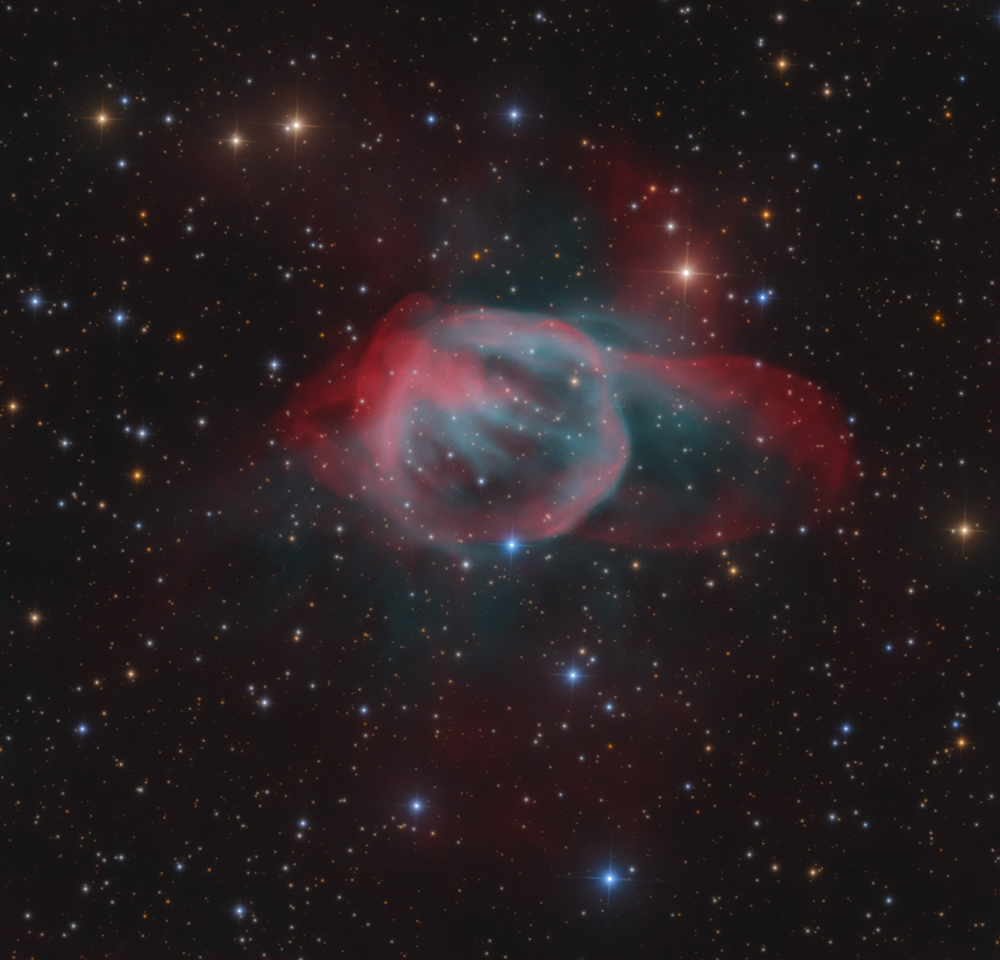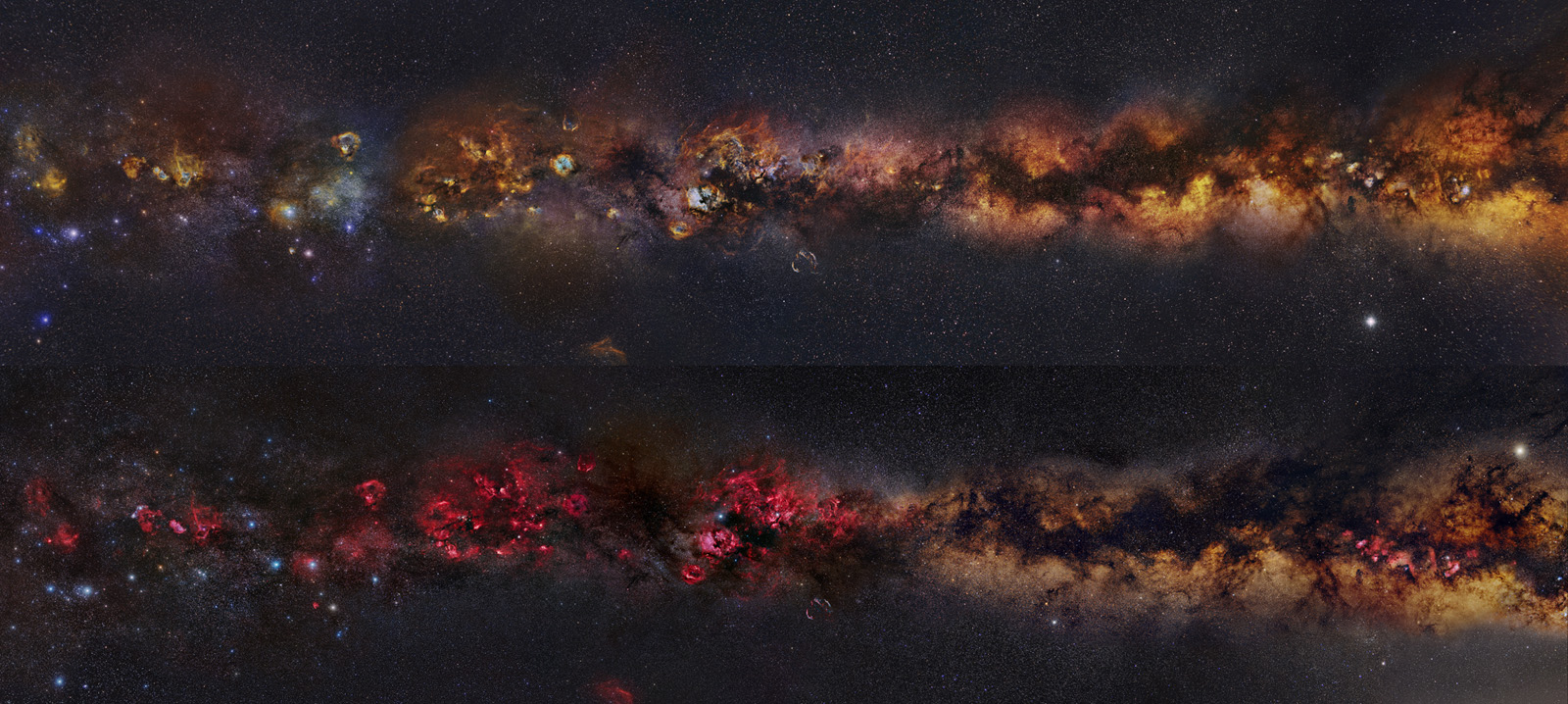Page 2 of 5
Re: Submissions: 2021 January
Posted: Thu Jan 07, 2021 7:51 pm
by jose
http://halfa.webcindario.com/IC-405410-HOSH15-CESAR.jpg
Hola a todos
A modo de regalo de Reyes me he montado estas dos nebulosas, y me he dicho:
os las dejo aqui haber que os parecen.
Una es del 2019 y la otra es del 2020, espero que os guste el montaje, los datos son estos::
IC 405
H alfa: 21 Light de 900 segundos; 25 flats, 21 darks y 40 bias
OIII: 20 Light de 900 segundos; 25 flats, 20 darks y 40 bias
SII: 16 Light de 900 segundos; 25 flats, 16 darks y 40bias
TOTAL:14 HORAS Y 15 MINUTOS
IC 410
H alfa: 15 Light de 900 segundos; 25 flats, 15 darks y 40 bias
OIII: 12 Light de 900 segundos; 25 flats, 12 darks y 40 bias
SII: 17 Light de 900 segundos; 25 flats, 17 darks y 40bias
TOTAL:11 HORAS
PALETA:
HUBBLE
R= SII
G= H-alfa
B= OIII
L= H-alfa
TEMPERATURA: -10 GRADOS
TUBO: FSQ 106 ED
CCD: SBIG ST-8300M
MONTURA: CGEM
CCD guiar: QHY5II
LUGAR: TORREJÓN DE ARDOZ y LAS INVIERNAS (GUADALAJARA)
Un saludo
jose
Re: Submissions: 2021 January
Posted: Fri Jan 08, 2021 8:45 pm
by tango33
A few new images for a happier new year...
Albireo:
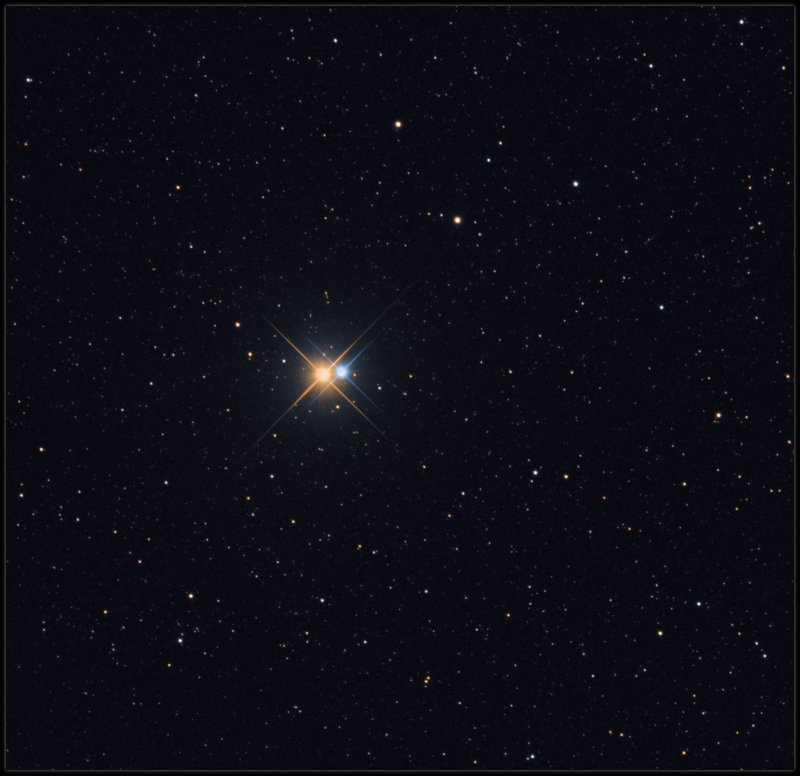
Messier 63:

Leo I galaxy:

LDN 115 region:

RCW 58:
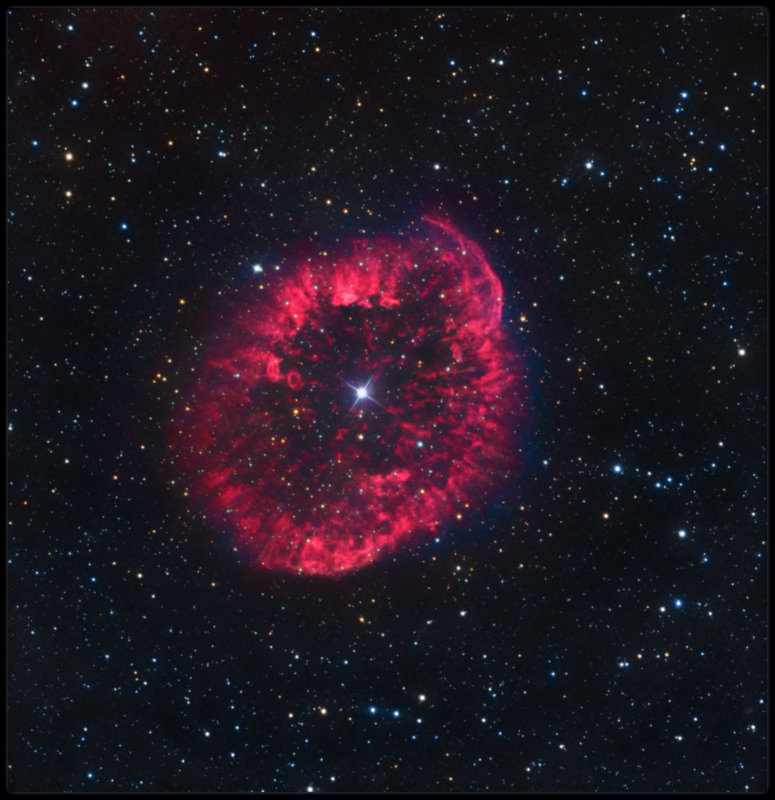
Full resolution and details:
https://pbase.com/tango33
All the best,
Kfir Simon
Re: Submissions: 2021 January
Posted: Sat Jan 09, 2021 9:09 am
by rhess
STROTTNER-DRECHSLER 1 / COCO'S NEBULA
StDr1 (PNG 185.1+-0.9) is a new spectrum confirmed planetary nebula (PN) in the constellation of Taurus.
The PN was discovered in October 2019 by the French-German research team Marcel Drechsler and Xavier Strottner.
The potential central star of StDr 1 is located at coordinates 05:53:48.86 +24:02:41.45.
If this star is used as a calculation basis, then StDr 1 is located at a distance of 9203 light years from Earth.
For a PN at this distance, it is unusually bright.
In addition, this photo was the first to detect an annular H-alpha structure around StDr 1.
*
Discoverers: Marcel Drechsler, Xavier Strottner
Photographer: Rochus Hess
Image processing: Marcel Drechsler
Location: Vega Observatory Haus der Natur Salzburg (Austria)
Telescope: 1 metre ASA telescope at the "Vega Observatory Haus der Natur Salzburg"
Camera: FLI MicroLine 16803
Exposure: 26x20min H-Alpha, 17x20min OIII and 6x5min RGB each, total 15.8 hours
Copyright: Rochus Hess
larger resolution
http://www.astrofotografie-hess.at/stdr1.html
full resolution
http://www.astrofotografie-hess.at/asse ... _large.jpg
e-mail:
rochus_hess@aon.at
Re: Submissions: 2021 January
Posted: Sat Jan 09, 2021 1:26 pm
by Kinch
Reworked....Abell 21 (Madusa Nebula) - Crop
Click on above for larger image.
Tak FSQ130 with Astrodon 5nm Filters.
Full details @
https://www.kinchastro.com/abell-21-202 ... ebula.html
Re: Submissions: 2021 January
Posted: Sun Jan 10, 2021 4:53 pm
by theurbanastronomer
Three snapshots of The Great Conjunction spread apart by 24 hours. The images are laid out aligned with the Equatorial Grid. This shows the actual movement of the planets across the three days. The images have been processed from 50% of 1250 frames each using PIPP, AstroSurface and Gimp. The Equatorial Grid is from Stellarium. The brightness of Jupiter's moons have been selectively increased to make it more visible.
Equipment: GSO 8 Inch F12 (x0.5), iOptron CEM25P, QHY5iii462C.
Copyright: Vineeth Kaimal
Website:
http://theurbanastronomer.com
Location: Bengaluru, India
Dates: 20-Dec-2020 , 21-Dec-2020 and 22-Dec-2020
Re: Submissions: 2021 January
Posted: Sun Jan 10, 2021 6:50 pm
by asymon
The Milky Way from Sagittarius to Cassiopeia in both Narrowband and True Color
http://www.woodlandsobservatory.com
Copyright: Alistair Symon
This is the culmination of most of my imaging work over the last 2 years. In total 186 images have been combined in a mosaic. 1600 hours of data was collected through H-alpha, SII, OIII and RGB filters using a combination of focal lengths (700mm, 530mm, 85mm, 35mm and 14mm). The resulting image shows the Milky Way from Sagittarius to Cassiopeia in both Narrowband using the Hubble Palette and True Color. Because the two Milky Way images were taken using very similar focal lengths for each of the images it makes for a nice side by side comparison. It's best viewed on a big screen! You can see the high resolution image here.
http://www.woodlandsobservatory.com/Two ... ys2020.htm
Re: Submissions: 2021 January
Posted: Sun Jan 10, 2021 9:01 pm
by Wissam Ayoub
Hi,
My submission:
The Lower's Nebula - SH2-261.
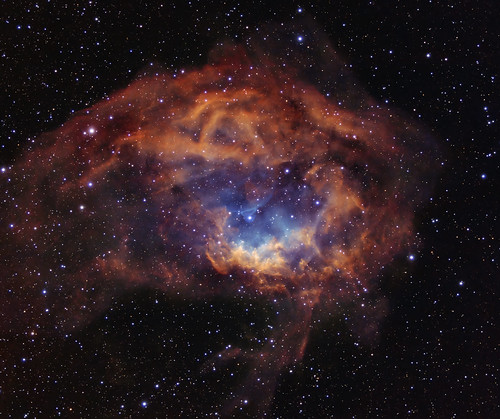
Imaging telescope: Explore Scientific 127mm ED TRIPLET APO.
Imaging camera: ZWO ASI294MM-Pro.
Mount: iOptron CEM60.
Chroma 3nm Ha: 10x600" (gain: 200.00) -20C bin 1x1.
Chroma 3nm OIII: 10x600" (gain: 200.00) -20C bin 1x1.
Chroma 3nm SII: 10x600" (gain: 200.00) -20C bin 1x1.
Total integration: 5.0 hours.
Imaging dates: Jan. 7, 2021, Jan. 8, 2021.
Imaging location: Abu Dhabi desert, UAE.
https://flic.kr/p/2kr1oih
Copyright: Wissam Ayoub.
Thank you,
Re: Submissions: 2021 January
Posted: Mon Jan 11, 2021 4:15 am
by astrofotoperu

Hi everyone,
Hope you are good and healthy! This is my best shot at the Omega Centauri star cluster (NGC 5139), right from my backyard in the middle of the city!
I did it with my scope at 2032 mm, one of the highest resolution shots I´ve ever done with my amateur telescope.
As polaris australis is very dim and low from my latitude, it´s very difficult to have a perfectly polar aligned telescope. After several attempts, I finally had a very good drift align, and pointed at this beautiful star cluster, the biggest and brightest in the nightsky!
High resolution image link:
https://astrofotoperudotcom.files.wordp ... 2032mm.jpg
10 Million Stars from a Light Polluted City!
Omega Centauri - NGC 5139 / Lima, Perú / 19.04.20
Telescope Celestron EDGE 8 HD @2032 mm f10
Mount: Celestron CGEM
Guiding System: Celestron Off Axis Guider
Guide camera: ZWO 174 MC
Main camera: ZWO 071 MC @ -10°
Focal reducer: None.
Filters: IDAS LPS (Light Pollution Supressor) D1
Exposure time: 129 / 120 second shots / 258 total exposure time
Software: SGP + Pixinsight + Photoshop
Re: Submissions: 2021 January
Posted: Mon Jan 11, 2021 4:01 pm
by StefanoDeRosa
Crescent Moon and Venus in twilight
https://stefanoderosa.com/
Copyright: Stefano De Rosa
please find attached two images, taken in the countryside few km away from Turin (Italy) before sunrise on January 11, 2021, showing the conjunction between a slender crescent Moon and Venus, immersed in the colours of twilight.
Best regards
Stefano De Rosa
Re: Submissions: 2021 January
Posted: Tue Jan 12, 2021 9:39 am
by Tom Glenn
Looking under the Moon (from Earth)--South Pole stereographic projection
 Lunar South Pole, stereographic projection (Earth based images)
Lunar South Pole, stereographic projection (Earth based images) by
Tom Glenn, on Flickr
This is a stereographic polar projection of the lunar South Pole, generated by map projecting standard Earth-perspective images that I captured with a C9.25 Edge HD telescope. Images from two dates, separated by more than two years, and differing in their lunar phase and libration values, were used in this composite. The most recent data was from last week. The resulting map shows the South Pole, as well as details beyond both the 90E and 90W meridians, which would not be possible in any single observation. Indeed, before the advent of orbital imagery, our knowledge of the polar regions and lunar far side was limited to what could be seen during strong libration events.
The map is also available with selected craters labeled below:
https://flic.kr/p/2krr1mc
In addition to documenting the detail within many craters of the South Polar region that are difficult to observe from Earth, this image clearly demonstrates how greater than 50% of the lunar surface is visible from Earth over a period of time, due to libration. The true South Pole lies on the rim of Shackleton crater, which is shown in the image. Many of the crater floors in this region are mired in perpetual shadow, due to the minimal axial tilt of the Moon with respect to the ecliptic plane. Conversely, many of the tall mountain peaks in the vicinity of the South Pole enjoy sunlight more than 90% of the time. In addition to the region near the pole, other notable features of the image include details across the 90 degree meridians, including albedo features of Sikorsky crater and Vallis Schrodinger to the southeast, on the lunar far side.
Capture details:
C9.25 Edge HD telescope, focal length 2350mm, f/10.
ASI183mm camera, green and red filters.
January 4, 2021, 11:50-12:08UT and July 20, 2018, 03:17-03:41UT.
San Diego, CA
Raw video files were stacked following normal lunar processing routines. The stacked images were then map projected using free software (WinJUPOS). In brief, a reference frame was set using ephemeris data and control points of known latitude and longitude in the images. The reference frame was then used to create a stereographic south polar projection, using planetocentric latitudes. Map projected images were then merged into the final composite in Photoshop. The full sized map presented here is 5600x5600px. The average image scale is ~475m/px, although a stereographic projection has some deviation in scale as a function of latitude, and there are also distortions at the extreme latitudes and longitudes of the image. These distortions arise from the extremely foreshortened view from Earth, which hides some data from view, and does not account for terrain elevation. Remarkably, most latitude and longitude coordinates throughout the map are within several kilometers accuracy when checked against known values (e.g. LRO data), notwithstanding the distortions noted above.
The image panels from which the map projection is composed are shown in the following link:
https://flic.kr/p/2krsFA2
Edited image scale typo, changed from 445m/px to 475m/px, although as noted above, scale is not constant in this projection, so this is simply an approximation
Re: Submissions: 2021 January
Posted: Tue Jan 12, 2021 10:55 am
by YSTY

Full quality here :
https://www.astrobin.com/m0nwut
Hi, here's my submission with my first dedicated astro camera.
M81 + M82 in some ifn.
Cold night here in France last night -13°C and a poor seeing but clear night are precious here !
41x600'' with no filters
22x600'' with l-extreme to get Ha regions
TS Photon 8'' 200/800 F4
Asi 2600mc-pro
EQ6R-pro
Guiding scope Altaïr 60/225
Guiding camera asi290mm mini
L-Extreme 2'' filter
N.I.N.A/ PHD2
Bortle 4
Total integration: 10h30
Date: 01/10/2021
Location: France
Author: Yann SAINTY
Re: Submissions: 2021 January
Posted: Tue Jan 12, 2021 12:07 pm
by Robin_Onderka
Cold winter night
Copyright:
www.instagram.com/robin_onderka | Robin Onderka
---
What a cold night! And the power pole seemed to point directly at the Andromeda Galaxy!
This photo was taken about 2 kilometers from the parking lot in Bumbálka on the Czechoslovak border. After a long time without a photo shoot (due to COVID-19 lockdown and bad weather), I didn't want to bother with the startracker, so it's only photographed from tripod using a 35 mm lens.
This photo is a panorama made of 70 photos and the editing really took me a long time. In addition, the light pollution from the surroundings made it even harder.
---
Canon 6D modified (Astronomik UV / IR) + Sigma 35 mm f/1.4
panorama - 13 sec, f/2.2 ISO 8000
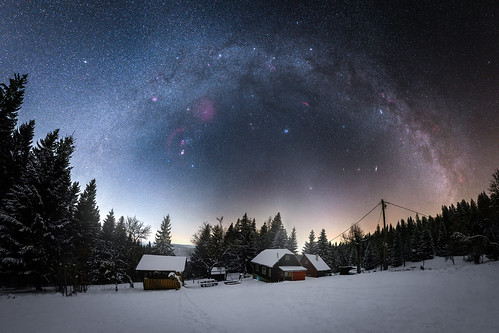 Cold winter night
Cold winter night by
Robin Onderka, on Flickr
Re: Submissions: 2021 January
Posted: Tue Jan 12, 2021 1:13 pm
by thomasroell
I would like to submit the following image for review for APOD.
Is a starless version of the
Flaming Star Nebula, IC 405. I really liked how the nebulosity kind of looks like a fire breathing dragon, or maybe an evil Seahorse with bad breath, whichever you prefer..
I hope you like it!
RGB 33 x 300 sec ISO 3200
Total exposure time 2 hours and 45 minutes
🖥 Edited in AstroPixel Processor, Starnet++, Photoshop and Lightroom
.

Sky-watcher HEQ5, TS-Optics 115/800 Triplet APO, Svbony 60 mm guidescope with a ZWO ASI120MM guidecamera.
🕹ZWO ASIAIR

Canon EOS 6Da, Optolong L-Enhance filter
Kind regards,
Thomas Röell
Instagram: @pilot_astro
Re: Submissions: 2021 January
Posted: Tue Jan 12, 2021 4:20 pm
by Wissam Ayoub
NGC 2174 - Monkey Head Nebula.

Imaging telescope: Explore Scientific 127mm ED TRIPLET APO.
Imaging camera: ZWO ASI294MM-Pro.
Mount: iOptron CEM60.
Chroma 3nm Ha: 10x600" (gain: 200.00) -20C bin 1x1.
Chroma 3nm OIII: 10x600" (gain: 200.00) -20C bin 1x1.
Chroma 3nm SII: 10x600" (gain: 200.00) -20C bin 1x1.
Total integration: 5.0 hours.
Imaging dates: Jan. 8, 2021, Jan. 9, 2021.
Imaging location: Abu Dhabi desert, UAE.
https://flic.kr/p/2krynJZ
Copyright: Wissam Ayoub.
Thank you,
Re: Submissions: 2021 January
Posted: Tue Jan 12, 2021 7:33 pm
by Goudig
Orion
https://www.bastienfoucher.com
Copyright: Bastien Foucher
A higher resolution version of the image is available here :
https://photos.smugmug.com/photos/i-8m7 ... m7fbQ6.jpg
A 76 hours total exposure, 24 tiles mosaic of Orion.
Re: Submissions: 2021 January
Posted: Tue Jan 12, 2021 11:53 pm
by Ronan Hunt
The Horsehead in HaRGB
 Horsehead in HaRGB
Horsehead in HaRGB by
Ronan Hunt, on Flickr
Re: Submissions: 2021 January
Posted: Tue Jan 12, 2021 11:55 pm
by Ronan Hunt
M42 RGB enhanced by SHO
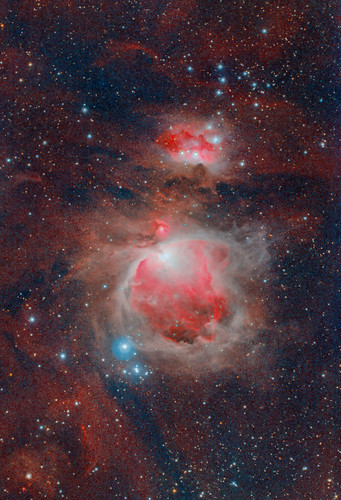 M42 in SHROGOB
M42 in SHROGOB by
Ronan Hunt, on Flickr
Re: Submissions: 2021 January
Posted: Tue Jan 12, 2021 11:55 pm
by Ronan Hunt
M42 in RGB
 M42 in RGB
M42 in RGB by
Ronan Hunt, on Flickr
Re: Submissions: 2021 January
Posted: Wed Jan 13, 2021 4:33 pm
by mdieterich
California Nebula and Pleiades region
www.mattdieterich.com
Copyright: Matt Dieterich
https://live.staticflickr.com/65535/508 ... fedc_b.jpg
How many deep sky objects can you spot in this widefield view of the night sky? At first glance one might think these are clouds in the sky, but the amazing cloud-like areas are dark nebulae of dense dust blocking starlight in our Milky Way Galaxy. I am absolutely blown away by the beauty of dark nebulae and the Winter Milky Way in general! I never realized the Pleiades had such widespread dark nebulae around it.
Re: Submissions: 2021 January
Posted: Wed Jan 13, 2021 8:19 pm
by ac4lt
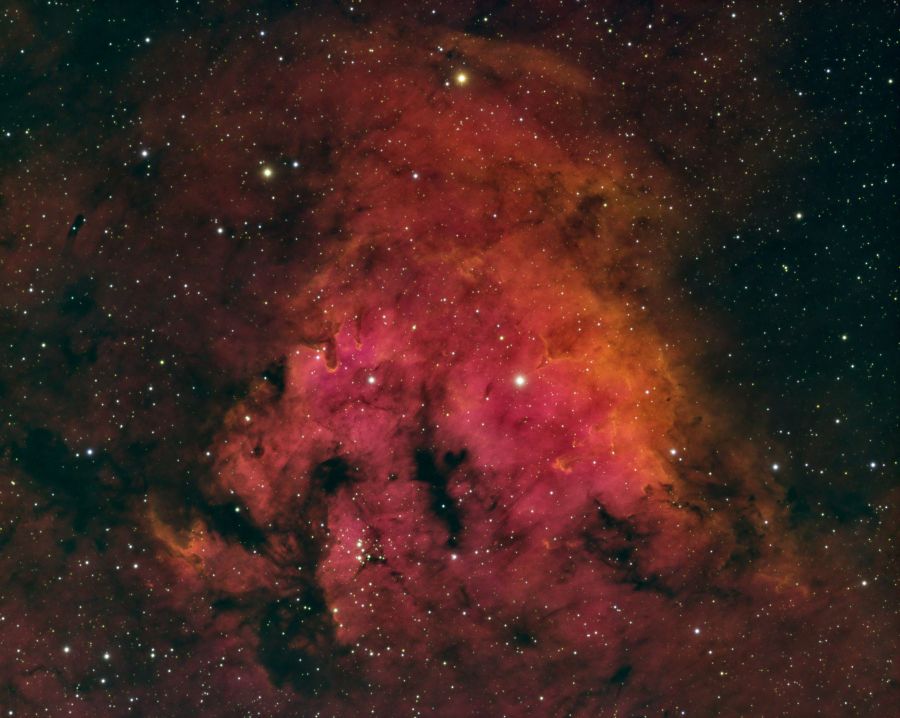
This is LBN 581 (also known as NGC 7822) in the HSO palette. It is 25.3 hours of data. LBN 581 is very strong in h-alpha and much weaker in both OIII and SII which may explain why it doesn't get a lot of love from imagers but I still found it an interesting object.
Full size version available on astrobin:
https://www.astrobin.com/kkb1q8/?nc=user
Re: Submissions: 2021 January
Posted: Wed Jan 13, 2021 9:34 pm
by Astrobrian
The Leo Triplet
https://www.astrobrian.com
https://www.instagram.com/astrobrian_
https://www.astrobin.com/users/astrobrian/
Copyright: Brian Rehrey
Link to Full Image:
https://flic.kr/p/2krW7gv
Equipment:
Imaging Camera: ASI183MM Pro
Imaging Scope: Zenithstar 61
Guide Camera: ASI120mm Mini
Guide Scope: ZWO 30mm F4
Mount: EQ6-R Pro
Filter Wheel: ZWO 8 Position EFW
Focuser: ZWO EAF
Filters: Optolong RGB Filters
Re: Submissions: 2021 January
Posted: Thu Jan 14, 2021 10:14 am
by lizarranet
Doomed Witch
The HII signal present in Orion surrounds the reflection nebula with such a peculiar shape.
Taken from
www.deepskychile.com
LHaRGB image
Details:
https://www.imagingtheuniverse.com/chil ... -la-bruja/
Autors:
Mikel Martinez (Instagram: @lizarranet) &
Cèdric Thomas
 IC2128-Witch head nebula
IC2128-Witch head nebula by
Mikel Martínez, en Flickr
Re: Submissions: 2021 January
Posted: Thu Jan 14, 2021 4:34 pm
by thomasroell
The Flaming Star Nebula, IC 405
RGB 33 x 300 sec ISO 3200
Total exposure time 2 hours and 45 minutes
🖥 Edited in AstroPixel Processor, Starnet++, Photoshop and Lightroom
.

Sky-watcher HEQ5, TS-Optics 115/800 Triplet APO, Svbony 60 mm guidescope with a ZWO ASI120MM guidecamera.
🕹ZWO ASIAIR

Canon EOS 6Da, Optolong L-Enhance filter
Kind regards,
Thomas Röell
Instagram: @pilot_astro
Re: Submissions: 2021 January
Posted: Thu Jan 14, 2021 6:48 pm
by andrystix
 La seggiola d'Orione UHD
La seggiola d'Orione UHD
by
andrystix
two panel merged with PS:
top: 49 shoots tracked with iOptron Sky Guider Pro (stacked with DSS) + 1 shoot of ground
bottom: 2 shoots for the ground
each shoot has the same setting: 40s, ISO800, f/4
exif: Nikon D750 (modded), AF-S NIKKOR 20mm f/1.8G ED, iOptron Skyguider Pro, Nisi Filter ND32
social: @andrystix on Instagram, Facebook and Flickr.
Re: Submissions: 2021 January
Posted: Thu Jan 14, 2021 7:33 pm
by pepe30
Hi,
I attach my attempt to the NGC 6995 – RGBHaOIII
http://astrobook.sk/2020/09/04/ngc-6995-rgbhaoiii/
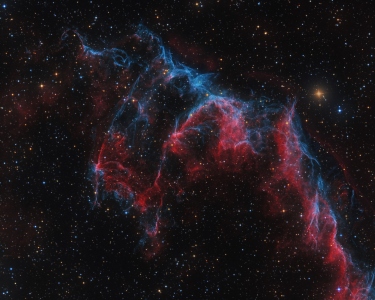
Peter





